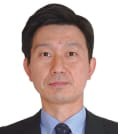- JST Home
- /
- Strategic Basic Research Programs
- /
 PRESTO
PRESTO- /
- project/
- Nanoengineering on Mechanical Functions of Materials/
- [Nanomechanics] Year Started : 2020
[Nanomechanics] Year Started : 2020
Yuji Ichikawa
Nano-Mechanochemistry at the Solid-State Particle Bonding Interface
Grant No.:JPMJPR2091
Researcher
Yuji Ichikawa

Associate Professor
Graduate School of Engineering
Tohoku University
Outline
The process of solid-state particle deposition is expected to be a novel material process for producing micro-meter order coatings to centimeter order thick components through collisional stacking of particles without melting. In this study, such processes will be examined as a series of nano-mechanochemical phenomena. The ultrafast deformation behaviors of materials in the nano-region of a solid-state bonding interface will be investigated. Additionally, the corresponding chemical changes and the physicochemical phenomena associated with bonding will be analyzed. This project challenges to extend the mechanics of materials for explaining nano-mechanochemical phenomena, which integrate deformation and chemical reactions in micro-materials.
Shintaro Itoh
Elucidation of lubrication mechanism of polymer boundary film by interfacial interaction measurements
Grant No.:JPMJPR2092
Researcher
Shintaro Itoh

Professor
Graduate School of Engineering
Nagoya University
Outline
The polymer boundary film formed on the solid surface exhibits high lubricity even under severe friction conditions. However, the film thickness is 1μm or less, and the mechanism of lubricity has not been fully understood. This research aims to elucidate the macroscopic lubrication mechanism from molecular-level phenomena. To that end, I will establish unique techniques such as nano-rheology measurement, X-ray reflectance measurement, and microfluidic device measurement that realize a multifaceted and hierarchical approach.
Shoichi Kikuchi
Multifunctional material design via forming periodic micro-strength gradient
Grant No.:JPMJPR2093
Researcher
Shoichi Kikuchi

Associate Professor
Faculty of Engineering
Shizuoka University
Outline
We establish a road map for forming multifunctional metallic materials via microstructural design. In order to clarify the superposition effect of dislocation structures and non-linear deformation behaviors on kinetic mechanism of metallic materials with periodic micro-strength gradient from both micro- and macro-scopical viewpoints, we evaluate the fatigue damage of each crystallographic grain and conduct a dynamic simulation. We claify the unique damage mechanism of materials having a network structure of high-strength phase surrounded the low-strength phase in fatigue.
Yasuhiro Kimura
Crystalline design of a metallic nanowire based on electromigration
Grant No.:JPMJPR2094
Researcher
Yasuhiro Kimura

Associate Professor
Graduate School of Engineering
Kyushu University
Outline
This project aims to propose the nanowire crystalline design technique based on atomic migration by electron flow, resulting in the higher mechanical properties of metallic nanowires. Electromigration, the physical phenomenon of metallic atomic diffusion with high-density electron flow, has to be controlled to obtain the desire crystal structure, grain size, and orientation of a wire, and thus the mechanical properties are assessed in wires with different crystalline nature. This crystalline design technique contributes to revealing the potential of a metallic nanowire in terms of the mechanical property that has not been attracted so far.
Daiki Siozawa
Development of non-destructive strength analysis technology for adhesive nanostructures
Grant No.:JPMJPR2095
Researcher
Daiki Siozawa

Associate Professor
Graduate School of Engineering
Kobe University
Outline
Multi-materialization is being promoted for mechanical structures in various fields, and the improvement of strength of bonding adhesion and nondestructive strength evaluation technique are required. In this project, the nanostructure and strain / stress field of resin materials and adhesives that are subject to mechanical load is measured using electromagnetic wave in various wavelength bands from visible light and infrared to the terahertz. By observing the effect of nanostructures on mechanical behavior, the fatigue strength mechanism of adhesive bonding is investigated.
Akinobu Shibata
Multiscale analysis on hydrogen-related crack propagation in high strength steels
Grant No.:JPMJPR2096
Researcher
Akinobu Shibata

Distinguished Group Leader
Research Center for Structural Materials
National Institute for Materials Science
Outline
In this project, the macroscopic mechanical responses corresponding to each stage of hydrogen embrittlement in high strength steels will be quantitatively evaluated. In addition, I plan to develop a novel multiscale analysis technique combining computer tomography and serial sectioning microstructure observation to study three-dimensional crack propagation behavior. Then, the discontinuous crack propagation behavior, which is an intrinsic characteristic of hydrogen embrittlement, will be analyzed by utilizing the newly developed multiscale analysis technique. The goal is to establish a new theory for the origin of macroscopic mechanical properties of hydrogen-related fracture from a nano-mechanical point of view through bridging of mechanical response and crack propagation behavior.
Kosuke Takahashi
Development of composites with superlong fatigue-life by detection and suppression of damege on nano-inteface
Grant No.:JPMJPR2097
Researcher
Kosuke Takahashi

Associate Professor
Faculty of Engineering
Hokkaido University
Outline
Fatigue failure of fiber reinforced plastics is said to be originated by delamination between the fiber and the matrix. This project aims to establish a technique to visualize the fatigue-damage in the vicinity of interface with space resolution of the order of 10 nm by in-situ fatigue test and observation at the synchrotron radiation X-ray nano-CT facility. The obtained CT-images are then directly compared with a fatigue-damage initiation calculated by large scale molecular dynamics simulation to clarify the fracture origin and the subsequent damage propagation behavior at the molecular scale.
Tasuku Nakajima
Establishment of principals for novel polymeric material “extremely prestretched network”
Grant No.:JPMJPR2098
Researcher
Tasuku Nakajima

Associate Professor
Faculty of Advanced Life Science
Hokkaido University
Outline
Soft materials based on polymer networks such as gel and rubber exhibit excellent deformability and stretchability derived from the coiled conformation of their nanoscale network strands. In this research project, I focus on an unexplored polymeric material “extremely prestretched network” with unique mechanical functions having extremely prestretched polymer network strands. I will establish methods for preparation of a polymer network whose network strands are extremely prestretched, which is strongly unfavorable in terms of free energy, and discover its unique macroscale mechanical properties originating from its nanoscale prestretched strands. The obtained novel materials will be widely applied as decomposable polymeric materials under mild conditions and materials that can be functionalized by mechanical force.
Nobuo Nakada
Toughening of steels by controling nano-scale internal stress
Grant No.:JPMJPR2099
Researcher
Nobuo Nakada

Professor
School of Materials and Chemical Technology
Tokyo Institute of Technology
Outline
Experimentally demonstrate that (001) cleavage fracture of martensitic steels is induced by microscopic internal tensile stress generated by phase transformations by macro/micro-scale mechanical testing. Furthermore, in order to clarify the dynamic variation of the internals stress state caused by carbide precipitation in micro- to nano-scales, novel techniques supported by molecular dynamics simulation is applied. The obtained results will indicate an ideal microstructure with nano alloy carbides to prevent cleavage fracture, which leads to further toughening of steels.
Youfeng Yue
Mechanical properties and innovative function creation of soft materials with layered structures
Grant No.:JPMJPR209A
Researcher
Youfeng Yue

Senior Researcher
Research Institute for Advanced Electronics and Photonics
National Institute of Advanced Industrial Science and Technology (AIST)
Outline
This research integrates the insights from the developed layered soft materials (gels, liquid crystalline polymers, and metal nanomaterials) to find the governing factors at the nanoscale (such as layered nanostructure, nanocrystalline structure, and photoinduced molecular motions) that determine the macroscopic mechanical properties of the structural materials. The ultimate aim of this research is to design new soft materials with excellent mechanical properties and the development of innovative materials with advanced functions by understanding the governing factors of mechanical properties at the nanoscale.













